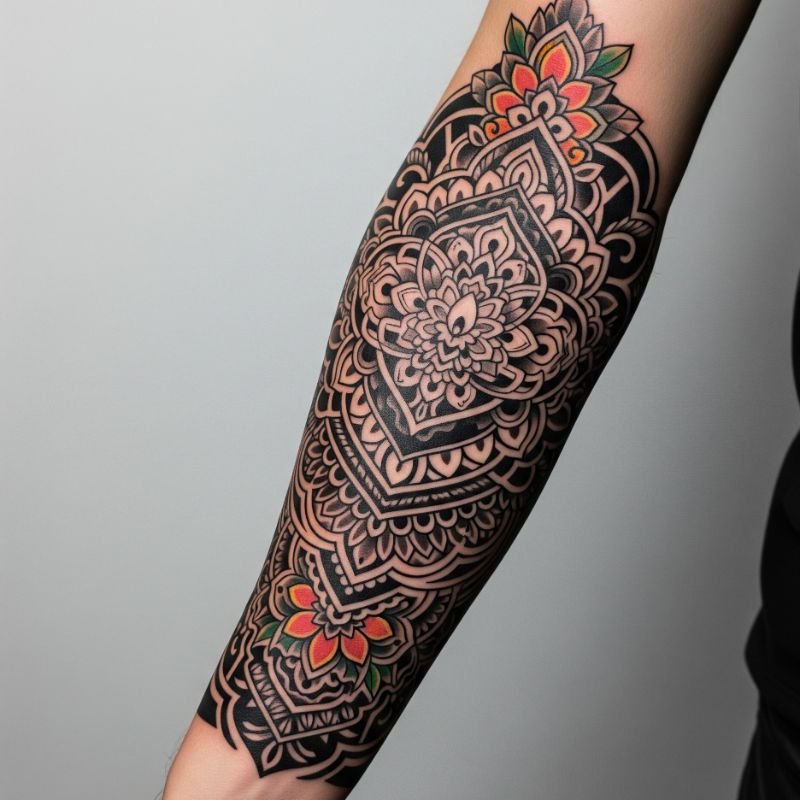How Long After a Tattoo Can You Safely Swim
Discover how long after a tattoo can you safely swim. Learn essential healing tips, water safety guidelines, and expert advice for protecting your new ink.
Getting a fresh tattoo is exciting, but let's be real here, it comes with some pretty strict rules. And if you're wondering "how long after a tattoo can you safely swim," you're definitely not alone. This question pops up constantly, especially during summer months when everyone's itching to hit the beach or pool.
Here's the thing though, jumping into water too soon after getting inked can seriously mess up your healing process. We're talking infections, faded colors, and potentially ruined artwork that you just dropped serious cash on. Nobody wants that nightmare, right?
This comprehensive guide will walk you through everything you need to know about swimming after getting a tattoo. From understanding the healing process to recognizing when it's actually safe to take that first dip, we've got you covered.
Understanding the Tattoo Healing Process
Before we dive into the swimming timeline, it's crucial to understand what's happening beneath your skin after getting tattooed. Your body treats a fresh tattoo like an open wound because, well, that's exactly what it is.
The tattooing process involves needles puncturing your skin thousands of times, depositing ink into the dermis layer. This creates tiny wounds that need time to heal properly. During the first few days, your tattoo will likely be red, swollen, and tender to the touch.
The Three Stages of Tattoo Healing
Stage One: Initial Healing (Days 1-6)
This is when your tattoo is most vulnerable. You'll notice some bleeding, oozing, and the formation of a thin scab. The area might feel warm and look pretty angry. This stage is absolutely critical for proper healing.
Stage Two: Peeling and Itching (Days 7-14)
Around day seven, you'll start seeing some peeling, similar to a sunburn. This is totally normal, but resist the urge to pick at it! The itching can drive you crazy, but scratching will only make things worse.
Stage Three: Deep Healing (Days 15-30)
Even though your tattoo might look healed on the surface, deeper layers are still doing their thing. The skin continues to regenerate and settle, which is why patience is key during this phase.
How Long After a Tattoo Can You Safely Swim: The Golden Rule
So, here's the million-dollar question: how long should you wait? Most tattoo artists and dermatologists agree that you should wait at least 2-4 weeks before swimming. However, this isn't a one-size-fits-all answer.
The general consensus is:
Minimum wait time: 2 weeks for small tattoos
Recommended wait time: 3-4 weeks for larger pieces
Safe bet: Wait until your tattoo is completely healed
But hold up, there's more to consider than just time. The type of water you're planning to swim in makes a huge difference too.
Pool Water vs. Natural Bodies of Water
Swimming Pools
Chlorinated pools might seem cleaner, but they're not necessarily safer for healing tattoos. The chemicals can irritate your fresh ink and slow down the healing process. Plus, public pools are breeding grounds for bacteria that can cause infections.
Oceans, Lakes, and Rivers
Natural bodies of water are generally considered riskier than pools. Ocean water contains salt that can be irritating, while lakes and rivers might harbor harmful bacteria like E. coli or other nasties you definitely don't want near your healing tattoo.
Hot Tubs and Spas
These are basically bacterial soup when it comes to healing tattoos. The warm water creates the perfect environment for bacteria to thrive, making infections much more likely.
Signs Your Tattoo Is Ready for Swimming
Knowing when your tattoo is healed enough for swimming isn't just about counting days on a calendar. You need to look for specific signs that indicate your skin has recovered properly.
Visual Indicators
Your tattoo should look settled and no longer raised or bumpy. The colors should appear vibrant and clear, without any haziness or dullness. There shouldn't be any scabbing, peeling, or flaking skin remaining.
Touch Test
Gently run your finger over the tattoo. It should feel smooth and no different from the surrounding skin. If it still feels raised, tender, or sensitive, it's not ready for water exposure.
No More Oozing or Weeping
Any discharge, clear fluid, or blood should have stopped completely. If you're still seeing any kind of weeping, your tattoo definitely needs more time to heal.
Water Safety Tips for Healed Tattoos
Even after your tattoo is fully healed, there are still some precautions you should take to keep your ink looking its best.
Pre-Swimming Preparation
Apply a thin layer of petroleum jelly or specialized tattoo balm before swimming. This creates a protective barrier between your tattoo and the water. Just remember to wash it off afterward.
Choose Your Swimming Spots Wisely
Stick to well-maintained pools or clean natural bodies of water. Avoid swimming in stagnant water, overly crowded pools, or areas with visible pollution.
Post-Swimming Care
Rinse off immediately after swimming to remove chlorine, salt, or any other potentially irritating substances. Pat your tattoo dry gently and apply a fragrance-free moisturizer.
What Happens If You Swim Too Soon?
Let's talk about the scary stuff that can happen if you ignore the waiting period. Swimming too soon after getting a tattoo can lead to some serious complications.
Infection Risks
Water contains bacteria that can enter your healing tattoo and cause infections. Signs include increased redness, warmth, pus, red streaking, or fever. If you notice any of these symptoms, get medical attention immediately.
Fading and Distortion
Prolonged water exposure can cause your tattoo ink to fade or blur. The healing process gets disrupted, and you might end up with a tattoo that looks nothing like what you originally wanted.
Prolonged Healing Time
Swimming too early can actually slow down your tattoo's healing process, meaning you'll have to wait even longer before it's fully recovered.
Special Considerations for Different Tattoo Locations
The location of your tattoo can affect how long you need to wait before swimming. Areas that bend frequently or are exposed to more friction generally take longer to heal.
Hand and Foot Tattoos
These areas are notorious for slow healing due to constant movement and exposure. You might need to wait 4-6 weeks before swimming.
Torso and Back Tattoos
These areas typically heal faster since they're less exposed to friction and movement. The standard 2-3 week waiting period usually applies.
Joint Areas
Tattoos near joints like elbows, knees, or ankles need extra time since the skin stretches and moves constantly during healing.
Professional Aftercare vs. DIY Methods
While your tattoo artist will give you specific aftercare instructions, it's worth understanding the difference between professional recommendations and home remedies you might find online.
Following Artist Instructions
Your tattoo artist knows their stuff, so follow their aftercare instructions to the letter. They understand how their technique and the specific inks they use affect healing time.
Avoiding Internet Myths
Don't believe everything you read online about speeding up healing or "safe" swimming tricks. Stick to proven methods and professional advice.
How Long After a Tattoo Can You Safely Swim: Factors That Affect Healing
Several factors can influence how quickly your tattoo heals and when it's safe to swim:
Personal Health
Your overall health, age, and immune system strength all play roles in healing speed. People with diabetes, autoimmune conditions, or other health issues may need to wait longer.
Tattoo Size and Complexity
Larger, more detailed tattoos take longer to heal than small, simple designs. The more trauma to your skin, the longer the recovery period.
Aftercare Quality
Following proper aftercare instructions religiously can significantly speed up healing time. Neglecting your tattoo will only prolong the process.
Environmental Factors
Hot, humid weather can slow healing, while cool, dry conditions typically promote faster recovery. Your lifestyle and daily activities also matter.
Alternative Water Activities During Healing
Just because you can't swim doesn't mean you have to avoid water entirely. Here are some alternatives to consider:
Shallow Water Activities
Wading in shallow water where your tattoo stays above the waterline is generally okay after the first week, as long as you're careful.
Showering Safely
Quick showers are fine, but avoid long, hot showers that can soften scabs and interfere with healing. Keep the water temperature lukewarm and don't scrub the area.
Water Sports to Avoid
Skip activities like surfing, water skiing, or diving until your tattoo is completely healed. These activities increase the risk of trauma to your healing skin.
When to Consult a Professional
Sometimes, despite your best efforts, things don't go according to plan. Here's when you should seek professional help:
Signs of Infection
If you notice increased redness, warmth, pus, or red streaking around your tattoo, see a healthcare provider immediately.
Healing Complications
If your tattoo isn't healing properly or you're experiencing unusual symptoms, consult your tattoo artist or a dermatologist.
Uncertainty About Healing Progress
When in doubt, it's always better to wait longer or get professional advice rather than risk damaging your tattoo.
Long-Term Tattoo Care and Swimming
Even after your tattoo is fully healed, proper care will help maintain its appearance for years to come.
Sun Protection
Always use sunscreen on your tattoo when swimming outdoors. UV rays can fade tattoo ink over time.
Regular Moisturizing
Keep your tattoo moisturized to maintain skin health and ink vibrancy. This is especially important if you're a regular swimmer.
Annual Touch-Ups
Consider getting touch-ups every few years to keep your tattoo looking fresh, especially if you swim frequently.
Conclusion
Understanding how long after a tattoo can you safely swim is crucial for protecting your investment and ensuring proper healing. While the general rule is 2-4 weeks, individual factors like tattoo size, location, and personal health can affect this timeline. Remember, patience is key when it comes to tattoo aftercare. Rushing into swimming too soon can lead to infections, fading, and other complications that could ruin your beautiful new artwork. When in doubt, wait a bit longer and consult with your tattoo artist or healthcare provider for personalized advice.
FAQs
1. Can I swim in a pool after 1 week with a new tattoo?
No, wait at least 2-4 weeks for proper healing and infection prevention.
2. Is ocean water worse than pool water for healing tattoos?
Both pose risks, but ocean salt can irritate while pools contain harsh chemicals.
3. What if my tattoo looks healed after 10 days?
Surface healing doesn't mean complete healing; deeper layers still need time to recover.
4. Can I use waterproof bandages to swim earlier?
No, waterproof bandages can trap moisture and bacteria, increasing infection risk significantly.
5. How do I know if my tattoo is infected from swimming?
Watch for increased redness, warmth, pus, fever, or red streaking around the area.


































